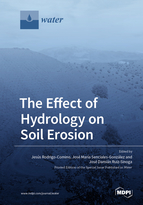The Effect of Hydrology on Soil Erosion
A special issue of Water (ISSN 2073-4441). This special issue belongs to the section "Hydrology".
Deadline for manuscript submissions: closed (1 March 2020) | Viewed by 53982
Special Issue Editors
2. Physische Geographie und Wissens- und Technologietransfer Universität Trier, D - 54296 Trier, Germany
Interests: Soil geography; soil erosion; land degradation
Special Issues, Collections and Topics in MDPI journals
Interests: river; geography; hydrography; fluvial geomorphology; soil geography; climate change
Special Issues, Collections and Topics in MDPI journals
Special Issue Information
Dear Colleagues,
Soil erosion is one of the most important environmental issues in natural and anthropized lands. Understanding the key parameters and factors of soil erosion will enable the conservation of soil system goods, services, and resources, and will avoid damage outside of fields caused by transported and accumulated sediments and water. The dynamics of erosive processes are changing, with new trends of pluviometric patterns due to well-identified climate change, which is becoming an extra factor in the soil degradation.
This Special Issue addresses the state-of-the-art of soil erosion and degradation processes and the accelerated rates due to hydrological processes and climate change. Studies focussed on the measurements, modelling, and experiments under field or laboratory conditions developed at different scales (pedon, hillslope, and catchment) are very welcome.
We welcome research on understanding the effects of hydrology in combination with other natural and anthropic mechanisms such as climate change, tillage, rill and interrill, gully formation, soil compaction and water losses, the decrease of soil quality or perceptions of the stakeholders, land degradation research, runoff generation, soil salinization, organic matter depletion, soil productivity, etc.
If your findings are unconventional, your method is new, and your research is provocative, submit your paper to our Special Issue, as we are looking for new and innovative scientific research.
Dr. Jesús Rodrigo-Comino
Dr. José María Senciales-González
Prof. Dr. José Damián Ruiz-Sinoga
Guest Editors
Manuscript Submission Information
Manuscripts should be submitted online at www.mdpi.com by registering and logging in to this website. Once you are registered, click here to go to the submission form. Manuscripts can be submitted until the deadline. All submissions that pass pre-check are peer-reviewed. Accepted papers will be published continuously in the journal (as soon as accepted) and will be listed together on the special issue website. Research articles, review articles as well as short communications are invited. For planned papers, a title and short abstract (about 100 words) can be sent to the Editorial Office for announcement on this website.
Submitted manuscripts should not have been published previously, nor be under consideration for publication elsewhere (except conference proceedings papers). All manuscripts are thoroughly refereed through a single-blind peer-review process. A guide for authors and other relevant information for submission of manuscripts is available on the Instructions for Authors page. Water is an international peer-reviewed open access semimonthly journal published by MDPI.
Please visit the Instructions for Authors page before submitting a manuscript. The Article Processing Charge (APC) for publication in this open access journal is 2600 CHF (Swiss Francs). Submitted papers should be well formatted and use good English. Authors may use MDPI's English editing service prior to publication or during author revisions.
Keywords
- hydrological processes
- soil erosion
- different scales
- modelling
- experiments








